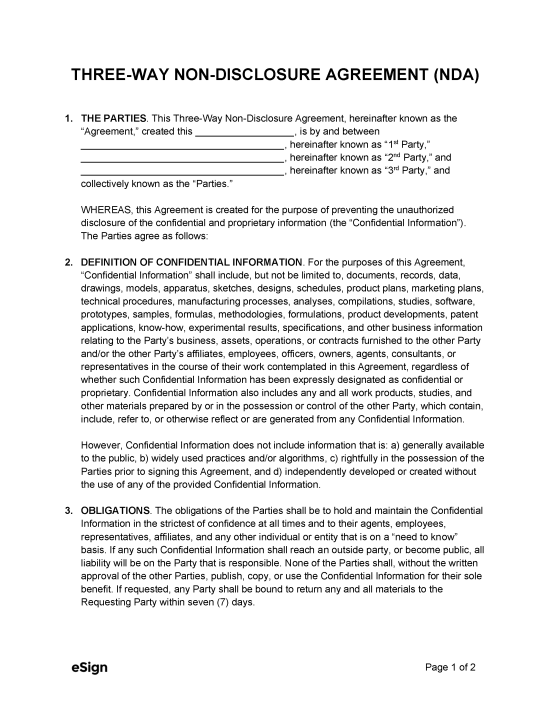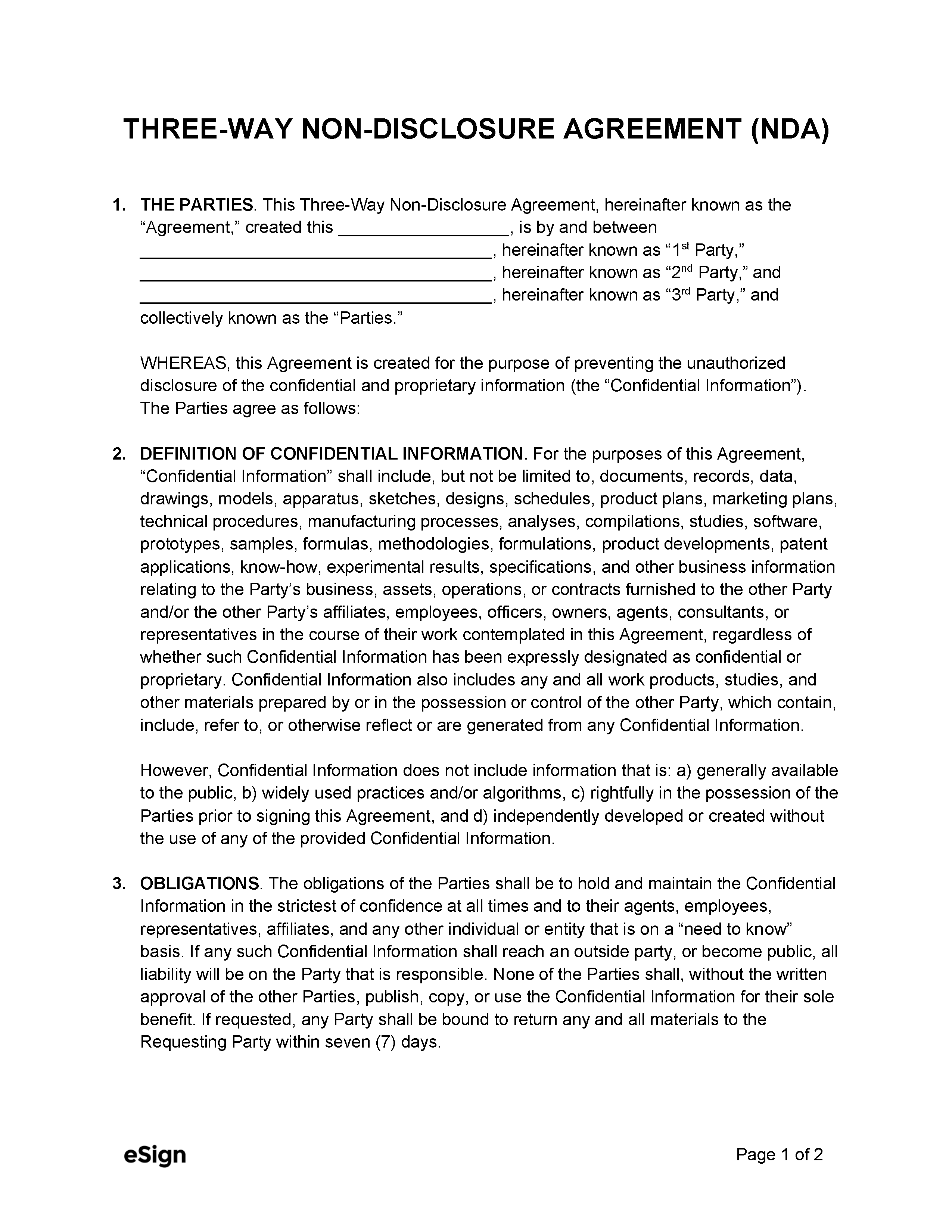When 3-Way NDAs Are Used
A three-way NDA allows three parties to share and receive confidential information without needing to create multiple bilateral agreements. This type of agreement can be used in:
- Joint ventures
- Research and development projects
- Business partnerships
- Project or contract negotiations
- Mergers and acquisitions
Sample
Download: Adobe PDF | MS Word | OpenDocument
THREE-WAY NON-DISCLOSURE AGREEMENT
1. THE PARTIES. This Three-Way Non-Disclosure Agreement, hereinafter known as the “Agreement,” created this [MM/DD/YYYY] is by and between [1ST PARTY NAME], hereinafter known as “1st Party,” [2ND PARTY NAME], hereinafter known as “2nd Party,” and [3RD PARTY NAME], hereinafter known as “3rd Party,” and collectively known as the “Parties.”
WHEREAS, this Agreement is created for the purpose of preventing the unauthorized disclosure of the confidential and proprietary information (the “Confidential Information”). The Parties agree as follows:
2. DEFINITION OF CONFIDENTIAL INFORMATION. For the purposes of this Agreement, “Confidential Information” shall include, but not be limited to, documents, records, data, drawings, models, apparatus, sketches, designs, schedules, product plans, marketing plans, technical procedures, manufacturing processes, analyses, compilations, studies, software, prototypes, samples, formulas, methodologies, formulations, product developments, patent applications, know-how, experimental results, specifications, and other business information relating to the Party’s business, assets, operations, or contracts furnished to the other Party and/or the other Party’s affiliates, employees, officers, owners, agents, consultants, or representatives in the course of their work contemplated in this Agreement, regardless of whether such Confidential Information has been expressly designated as confidential or proprietary. Confidential Information also includes any and all work products, studies, and other materials prepared by or in the possession or control of the other Party, which contain, include, refer to, or otherwise reflect or are generated from any Confidential Information.
3. OBLIGATIONS. The obligations of the Parties shall be to hold and maintain the Confidential Information in the strictest of confidence at all times and to their agents, employees, representatives, affiliates, and any other individual or entity that is on a “need to know” basis. If any such Confidential Information shall reach an outside party, or become public, all liability will be on the Party that is responsible. None of the Parties shall, without the written approval of the other Parties, publish, copy, or use the Confidential Information for their sole benefit. If requested, any Party shall be bound to return any and all materials to the Requesting Party within seven (7) days.
4. TIME FRAME. The bounded Parties’ duty to hold the Confidential Information in confidence shall remain in effect until such information no longer qualifies as a trade secret or written notice is given releasing such Party from this Agreement.
5. INTEGRATION. This Agreement expresses the complete understanding of the Parties with respect to the subject matter and supersedes all prior proposals, agreements, representations, and understandings. This Agreement may not be amended except in writing with the acknowledgment of the Parties.
6. SEVERABILITY. If a court finds that any provision of this Agreement is invalid or unenforceable, the remainder of this Agreement shall be interpreted so as best to affect the intent of the Parties.
7. ENFORCEMENT. The Parties acknowledge and agree that due to the unique and sensitive nature of the Confidential Information, any breach of this Agreement would cause irreparable harm for which damages and/or equitable relief may be sought. The harmed Party in this Agreement shall be entitled to all remedies available at law.
8. GOVERNING LAW. This Agreement shall be governed under the laws in the State of [STATE NAME].
WITNESS WHEREOF, the parties hereto have executed this Agreement as of the date written below.
[1ST PARTY NAME] Signature: ________________________ Date: [MM/DD/YYYY]
[2ND PARTY NAME] Signature: ________________________ Date: [MM/DD/YYYY]
[3RD PARTY NAME] Signature: ________________________ Date: [MM/DD/YYYY]

